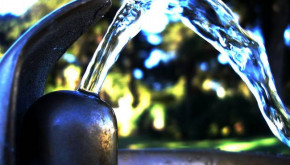
Did you know forests make great water? Or that some forest soils can absorb over 15” of rain/hour compared to a lawn which can absorb only an inch or less of water/hour while pavement doesn’t absorb any rain at all?
Next to me is a MN Women’s Woodland Network mug filled with tap water and tomorrow’s forecast calls for thunderstorms and heavy rain. I’m reminded of just how closely these two things are linked.
I’m sure you all know hydrology basics but a quick refresher may be in order. When rain falls from the clouds one of three things happens: it’s absorbed by plants and evapotransported back into the air; it filters through the soil and ground into aquifers; or it runs, often through macropores in the soil, to nearby streams and rivers as surface water. So tomorrow when it rains in the Blufflands of SE Minnesota, which are 40% forests and 96% owned by family woodland landowners, some of those forests could absorb up to 15” of rain/hour. Of that 60-70% of the rain will eventually go back to the atmosphere via evapotranspiration. This will create more clouds and allow it to rain elsewhere. In this region of karst geology, water also moves through macropores created by roots, wildlife tunnels and porous limestone to either filter into the aquifers that provide drinking water to Rochester and other communities in SE Minnesota, or the water will work its way through the landscape to the many rivers and streams (including numerous trout streams) that eventually lead to the Mississippi River.
To be clear, this hydrologic process can take days, weeks or years to complete and changes drastically between seasons. In the northern, cold areas of the North America very little water is absorbed into the system in winter when water is frozen and falls as snow, but when spring arrives, that stored precipitation moves through these same three cycles allowing plants and animals to more readily access this valuable resource. Also, most groundwater recharging happens in the spring and fall.
According to Brian Swistock’s, Water Resource Specialist at Penn State Extension, wonderful webinar, the Importance of Forests to Water, forests handle heavy precipitation “better than other managed surfaces.” This is particularly important because with climate change the Lake States are getting wetter. In Minnesota there’s been 37% more “observed change in very heavy precipitation.”
However only 40% of SE Minnesota’s Blufflands are forested. The majority of the landscape is in agriculture with pockets of development. Data for agriculture land absorption is hard to find but varies with cover type, time of year (annual or perennial crops) and if the fields are tiled. After a fair bit of digging I was able to track down an expert opinion that on average, most agricultural soils in this area can absorb between 0.6-2” of rain/hour; more than most yards but much less than forests. This is one of the main reasons forests produce great drinking water.
Forests can process a lot of water at a time for several reasons. As rain falls it hits the forest canopy, high above the ground, thus slowing down rainfall. Some rainfall will filter through the leaves to the ground while some will slide down the tree via the branches and truck. Once rain reaches the forest floor much of it (60-70%) will be evapotransported via trees and other plants back into the atmosphere. The remaining water will, at varying speeds, works its way through tunnels, root channels and other aspects of soil structure to springs and seeps that lead to rivers or aquifers. So in many ways forests are like very large, complex sponges able to absorb lots of water. Unlike more manipulated landscapes like crop fields, yards and urban areas, where compression and vegetation changes have reduced the plant cover and macropore soil characteristics that allow the sponge-like water systems of a forest to function.
This lesson isn’t new to many, but to the rain and water blessed areas of the eastern US it may be overlooked. “One third of the world’s 105 largest cities obtain a significant portion of their drinking water from protected areas and well managed natural forests provide benefits to urban populations in terms of high quality drinking water (from Running Pure, a research report by the World Bank/WWF Alliance for Forest Conservation and Sustainable Use).”
Now, I’ll drink my water with more respect and reverence for the forests that helped produce it. I’m also invigorated to continue to manage these forests to conserve them as viable ecosystems able to provide goods and services for us and countless other plants and animals.
Resources:
Forest to Faucets, US Forest Service
Importance of Forests to Water, Penn State Extension webinar
Running Pure, World Bank/WWF Alliance for Forest Conservation and Sustainable Use
SE Landscape Committee reports, MN Forest Resource Council

